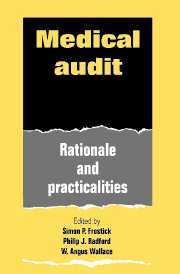Book contents
- Frontmatter
- Contents
- List of contributors
- Foreword
- Foreword
- 1 Introduction
- 2 Audit: historical and future perspectives
- 3 Audit philosophy
- 4 Medical audit: a view from the centre
- 5 Audit: a view from the Royal College of Surgeons of England
- 6 The regional viewpoint
- 7 Medical audit: the needs of the District Health Authorities
- 8 Resource management and budget holding
- 9 Unit and district information systems
- 10 Read codes and medical audit
- 11 Data capture direct from doctors
- 12 Computer systems: practice, limitations and pitfalls
- 13 Paediatric audit
- 14 Audit in obstetrics and gynaecology
- 15 Audit in general surgery
- 16 Orthopaedic audit: guidelines and hints
- 17 Installing audit in general practice and general dental practice
- 18 Clinical audit in psychiatry. Models for audit in mental health
- 19 Audit in anaesthesia
- 20 Audit in intensive care
- 21 Medical audit: lessons from the USA
- 22 Quality control in health care: the Dutch experience
- 23 Medical audit: experience from Sweden
- 24 Performance indicators
- 25 Measuring outcome and quality control
- 26 Audit: will it work?
- 27 What has been achieved so far?
- 28 A practical guide to audit
- Index
16 - Orthopaedic audit: guidelines and hints
Published online by Cambridge University Press: 30 September 2009
- Frontmatter
- Contents
- List of contributors
- Foreword
- Foreword
- 1 Introduction
- 2 Audit: historical and future perspectives
- 3 Audit philosophy
- 4 Medical audit: a view from the centre
- 5 Audit: a view from the Royal College of Surgeons of England
- 6 The regional viewpoint
- 7 Medical audit: the needs of the District Health Authorities
- 8 Resource management and budget holding
- 9 Unit and district information systems
- 10 Read codes and medical audit
- 11 Data capture direct from doctors
- 12 Computer systems: practice, limitations and pitfalls
- 13 Paediatric audit
- 14 Audit in obstetrics and gynaecology
- 15 Audit in general surgery
- 16 Orthopaedic audit: guidelines and hints
- 17 Installing audit in general practice and general dental practice
- 18 Clinical audit in psychiatry. Models for audit in mental health
- 19 Audit in anaesthesia
- 20 Audit in intensive care
- 21 Medical audit: lessons from the USA
- 22 Quality control in health care: the Dutch experience
- 23 Medical audit: experience from Sweden
- 24 Performance indicators
- 25 Measuring outcome and quality control
- 26 Audit: will it work?
- 27 What has been achieved so far?
- 28 A practical guide to audit
- Index
Summary
Introduction
As with all other specialties, orthopaedic and trauma surgeons have been undertaking ‘audit’ in its broadest sense for decades. However, in terms of formalised, structured audit orthopaedics is well behind other specialties. It is self-evident that for any specialty to develop some form of systematic review has to be undertaken. Orthopaedic surgery differs from many specialties in that the true effect of any treatment/management regime and any complications that may arise may not be apparent for many years. Audit in orthopaedics must, therefore, be looked at in two levels – (i) short-term effects and (ii) the eventual outcome whenever that occurs. Any guidelines to implement audit in the specialty have to include review at both levels. Further, in order to be realistic about audit in orthopaedics resource management cannot be ignored. Many orthopaedic operations involve the use of expensive implants. There is a tendency to use the ‘flavour of the month’, which may also be the most costly available at the time. Orthopaedic surgeons must, therefore, act responsibly in using new implants and be able, and willing, to justify their use when challenged.
Like many other specialties orthopaedics has undergone dramatic and irreversible changes in the last 20 years or so.
- Type
- Chapter
- Information
- Medical Audit , pp. 223 - 239Publisher: Cambridge University PressPrint publication year: 1993

